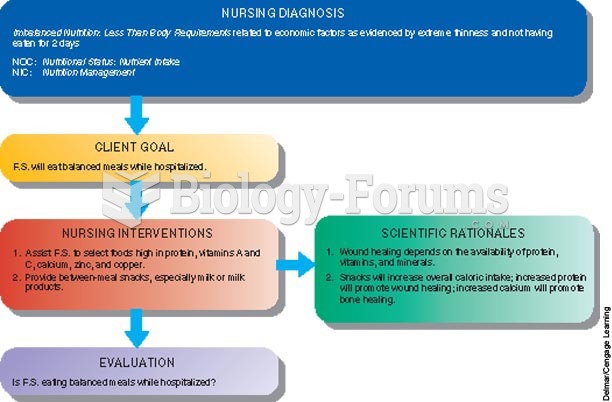Answer to Question 1
Correct Answer: 4
Rationale 1: Although normal aging includes a decline in skin turgor, this does not affect the metabolism of vitamins.
Rationale 2: The normal aging process does not increase renal excretion of fat-soluble vitamins in the urine.
Rationale 3: Aging does not cause a stagnation of liver enzymes that aid in the dissection of water-soluble vitamins.
Rationale 4: As part of the normal aging process, gastric absorption is reduced, causing decreased absorption of vitamins.
Global Rationale: With normal aging, the absorption of food diminishes and the quantity of ingested food is often reduced, leading to a higher risk of vitamin deficiencies in older adults. Although normal aging includes a decline in skin turgor, this does not affect the metabolism of vitamins. The normal aging process does not increase renal excretion of fat-soluble vitamins in the urine. Aging does not cause a stagnation of liver enzymes that aid in the dissection of water-soluble vitamins.
Answer to Question 2
Correct Answer: 1,2,3,4
Rationale 1: Vitamin A (Aquasol A) is a fat-soluble vitamin and can cause hypervitaminosis when taken in large doses.
Rationale 2: Large doses of fat-soluble vitamin E (Aquasol E) can cause hypervitaminosis.
Rationale 3: Hypervitaminosis can be caused by the fat-soluble vitamin D (Rocaltrol).
Rationale 4: Vitamin C (ascorbic acid) has been associated with hypervitaminosis.
Rationale 5: The water-soluble vitamin B2 (riboflavin) is not likely a factor in hypervitaminosis.
Global Rationale: Hypervitaminosis, or toxic levels of vitamins, has been reported for vitamins A, C, D, E, B6, niacin, and folic acid. The water-soluble vitamin B2 (riboflavin) is not likely a factor in hypervitaminosis. The water-soluble vitamin B2 (riboflavin) is not likely a factor in hypervitaminosis.







